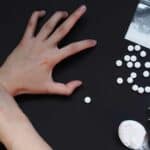Librium can stay in your system for between 5 to 10 days after the last dose. Drug tests can detect Librium use for approximately 5 days later.
Librium is a long-acting benzodiazepine with effects that can last for several days. Its main ingredient, chlordiazepoxide, has a longer duration of action than many other drugs of the same time. Librium is a schedule IV controlled substance with a potential for drug abuse.
Drug testing methods for Librium use may be performed during an addiction treatment program to establish or maintain a tapering schedule. They may also be performed in hospital settings if you are exhibiting side effects of a substance use disorder, or by law enforcement.
Half-Life Of Librium
The half-life of a drug is the period of time where a drug decreases to half of its maximum concentration after it is taken. Half-life times can be used to determine when a drug leaves the body. After five half-life cycles, most drugs are virtually eliminated from the body.
The half-life of Librium may be anywhere between 24 to 48 hours on average. Five half-life cycles of Librium may be anywhere between 120 to 240 hours, or 5 to 10 days. Librium can have a long half-life compared to other common benzodiazepines, such as Xanax and Ativan.
Librium’s half-life may be affected by the frequency of use and dosage.
Your personal health, such as your body mass, liver function, and history of substance abuse may also affect Librium’s half-life. While Librium is in your body, you may experience effects such as drowsiness, sedation, and reduced anxiety.
Drug Testing & Detection Times For Librium Use
Drug tests for Librium use may detect chlordiazepoxide or one of Librium’s metabolites. Metabolites are components of the drug that result from the body’s absorption process.
The main metabolites of chlordiazepoxide are oxazepam and nordiazepam. These metabolites are also present in other prescription benzodiazepines, such as Valium and Serax. The detection window of nordiazepam may be significantly longer than other metabolites.
Positive test results for these metabolites may not be specific to one benzodiazepine, due to the common metabolites shared among them.
Urine Test
Urine tests can detect chlordiazepoxide and oxazepam for about 5 days after the last use, and nordiazepam for about 10 days after the last use.
Urine tests may be a common testing method in medical settings due to their long detection time and relative convenience. Falsifying a urine test in order to obtain favorable results may have legal consequences.
Blood Test
Blood tests can detect Librium use for several days after the last use. As a long-acting benzo, Librium can stay in the bloodstream for an extended length of time while the effects of Librium are ongoing.
Blood tests may be a less common testing method due to their invasive nature and short detection window.
Saliva Test
Saliva tests can detect Librium and its metabolites for several days after the last use. The accuracy of saliva tests may increase in the short-term, or immediately after Librium ingestion occurred.
Hair Test
Hair tests can detect Librium and its metabolites for up to 90 days after the last use. Their long detection window may be due to substances ending up in hair follicles through the bloodstream, and remaining there as the hair grows out.
Librium Addiction Treatment Options
If you exhibit signs of addiction or Librium withdrawal symptoms in a medical setting, you may be subject to a drug test. A positive drug test for Librium use may be a sign of a substance use disorder.
Substance use disorder treatment for benzodiazepines may involve a medical detox, where the drug is flushed out of your system while your health is closely monitored. Subsequent treatment may involve mental health services and counseling in an inpatient or outpatient setting.
To find out if our substance use disorder treatment program works for you or your loved one, please contact Northeast Addictions Treatment Center today.
Sources
Written by
Northeast Addition Editorial Team
©2024 Northeast Addition Center | All Rights Reserved
This page does not provide medical advice.




